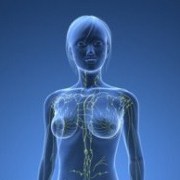 Photo: Getty Images
Photo: Getty Images
The lymphatic system is an important part of the immune system. It contains organs, lymph nodes, ducts and vessels that manufacture and deliver lymph from body tissues into the bloodstream. The adenoids and tonsils, spleen and thymus are also part of the lymphatic system.
Lymph is clear fluid that moves through the arteries. It is made up of white blood cells which target bacteria, and chyle which is a fluid containing fats and proteins. Chyle is found in the intestines.
The circulation of lymph through body tissue cleanses the tissue, draining after this process through the lymphatic system's lymphatic channels and nodes.
Lymph nodes are small organs shaped like beans, and are located in the center of the chest, the abdomen, the armpits, the neck and groin. These nodes are filters which trap and remove toxins including bacteria, viruses and cancer cells. Lymph nodes swell when they produce more white blood cells to remove toxins.
Lymph nodes from under the arm may be removed when a woman has invasive breast cancer. These nodes are examined for cancer cells.
If cancer cells are found, this is called lymph node involvement. Lymph node involvement is a significant indicator of higher risk that the cancer will spread.
The lymphatic system protects the body from infection. Unfortunately cancer cells from many types of cancers including breast cancer, also travel the lymphatic system in their attacks upon body organs.
To add insult to injury, cancer cells use the lymphatic system to attack lymph nodes as well. This spread of cancer to organs is called metastasis.
Research from Saint Louis University has uncovered a possible way to inhibit the flow of cells and fluid out of tissues into lymphatic vessels. The hope is that this data will facilitate the prevention of the spread of cancers, including breast cancer.
An April 10, 2011 Sciencedaily.com article reported that molecules called CRSBP-1, or LYVE-1, ligands (growth factors and cytokines) bind to CRSBP-1 receptors. These receptors are found on the surface of lymphatic vessels.
A response is initiated that enables entrance to the lymphatic vessel network. This is one method by which cancer cells invade the lymphatic system.
The SLU research has learned more about this process, with the goal of developing means to block metastasis and treat edema, which is swelling caused by a build-up of fluid. In breast cancer, this lymphedema can severely restrict functionality of a woman's arm and hand.
The study was the subject of the April 15, 2011 edition of the Journal of Cell Science. Research was funded by grants from the National Institutes of Health.
Sources:
Lymph system
http://www.nlm.nih.gov/medlineplus/ency/article/002247.htm
What Are "Lymph" and `"Lymph Nodes"?
http://www.breastcancer.org/treatment/surgery/lymph_node_removal/lymph_nodes.jsp
Lymph Node Involvement
http://www.breastcancer.org/symptoms/diagnosis/lymph_nodes.jsp
Outsmarting Cancer Cells: Scientists Learn How They Spread
http://www.sciencedaily.com/releases/2011/04/110408114402.htm
Visit Jody's website and blog at http://www.ncubator.ca and http://ncubator.ca/blogger
Reviewed September 7, 2011
by Michele Blacksberg R.N.





Add a CommentComments
There are no comments yet. Be the first one and get the conversation started!